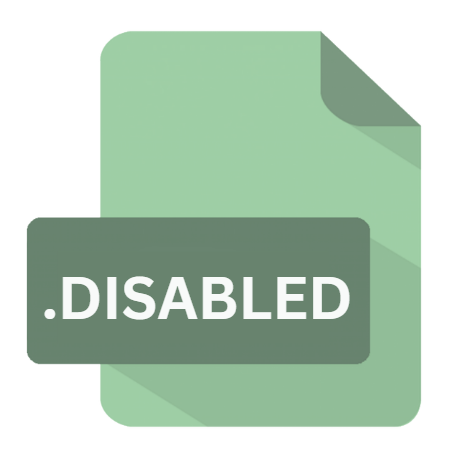.DISABLED File Extension

Spybot - Search & Destroy Disabled File
| Developer | Safer Networking |
| Popularity | |
| Category | Misc Files |
| Format | .DISABLED |
| Cross Platform | Update Soon |
What is an DISABLED file?
The .DISABLED file extension is associated with Spybot – Search & Destroy, a popular anti-malware tool.
These files are used by the application to denote certain files or settings that have been disabled within its system.
Unlike standard file types used for data storage or multimedia content, .DISABLED files are more about configuration and status tracking, particularly in the context of malware detection and system protection.
More Information.
The .DISABLED file extension was introduced as part of Spybot – Search & Destroy’s development to offer an efficient way to track and manage disabled elements within the software.
Initially, the purpose of these files was to support Spybot’s ability to disable certain features or components temporarily without permanently removing or deleting them.
This functionality allows users to manage their anti-malware settings flexibly and ensures that disabled components can be reactivated if needed.
The history of the .DISABLED file extension is closely tied to the evolution of Spybot – Search & Destroy. As the software evolved to include more features and settings, the .DISABLED file extension became an essential part of its configuration management.
Over time, it has played a critical role in maintaining the software’s effectiveness by allowing for easy management of its various components.
Origin Of This File.
Spybot – Search & Destroy, developed by Safer-Networking Ltd, is a well-known anti-malware program designed to identify and eliminate spyware, adware, and other malicious software from a computer.
The .DISABLED file extension is a part of the internal mechanisms used by Spybot to manage and track the status of various components and settings within the software.
The use of .DISABLED files originates from the need for a straightforward method to handle disabled items or settings in Spybot’s configuration.
These files provide a simple way to indicate that a specific component or setting is not currently active, ensuring that Spybot can effectively manage its operations and maintain accurate status information.
File Structure Technical Specification.
The .DISABLED file extension itself does not represent a specific file format or structure with defined specifications.
Instead, it is used by Spybot – Search & Destroy as a simple indicator that a particular file or setting has been disabled.
In technical terms, .DISABLED files are generally small text or binary files that contain minimal data. They typically include information related to the disabled status of specific features or settings within Spybot.
The file structure is designed to be lightweight and efficient, focusing on providing necessary status information without adding unnecessary complexity.
How to Convert the File?
The .DISABLED files are not designed for conversion into other formats, as they are not meant to store data in a way that would be useful outside the context of Spybot – Search & Destroy.
Their primary role is to indicate the disabled status of various components within the software.
If you need to manage or modify settings related to .DISABLED files, it is best to use Spybot – Search & Destroy’s built-in tools and interfaces.
Attempting to convert or manipulate these files outside of the software could lead to unexpected behavior or issues with the application.
Advantages And Disadvantages.
Advantages:
- Efficient Management: The .DISABLED files offer an efficient way to manage and track disabled settings or components within Spybot – Search & Destroy. This helps in maintaining an organized and functional anti-malware system.
- Flexibility: By using .DISABLED files, users can easily disable and re-enable various features or settings without permanently removing them. This flexibility is beneficial for managing system performance and malware protection.
- Minimal Impact: The files are typically small and have minimal impact on system resources, ensuring that Spybot – Search & Destroy operates efficiently.
Disadvantages:
- Limited User Visibility: .DISABLED files are primarily intended for internal use by Spybot, which means users generally do not interact with these files directly. This limited visibility can be a disadvantage for users who may want to understand more about the software’s internal workings.
- Potential Confusion: Users unfamiliar with the purpose of .DISABLED files might find their presence confusing, particularly if they come across these files outside of the Spybot environment.
How to Open DISABLED?
Open In Windows
- Viewing: Since .DISABLED files are often simple text or binary files, you can use text editors like Notepad or more advanced editors like Notepad++ to view their contents. However, editing these files directly is not recommended unless you are familiar with Spybot’s internal workings.
- Managing: Use Spybot – Search & Destroy’s interface to manage settings related to .DISABLED files.
Open In Linux
- Viewing: On Linux systems, you can use text editors like Gedit, Nano, or Vim to view .DISABLED files. As with other operating systems, direct editing is generally discouraged.
- Managing: Similar to macOS, Spybot – Search & Destroy is not available for Linux, so handling .DISABLED files on Linux is rare.
Open In MAC
- Viewing: To view .DISABLED files on macOS, you may need to use text editors that support a wide range of file types, such as TextEdit or third-party editors like Sublime Text. However, since Spybot – Search & Destroy is a Windows-based application, managing .DISABLED files on macOS is not typical.
- Managing: Spybot – Search & Destroy is not natively available for macOS, so .DISABLED files are not commonly encountered on this platform.











